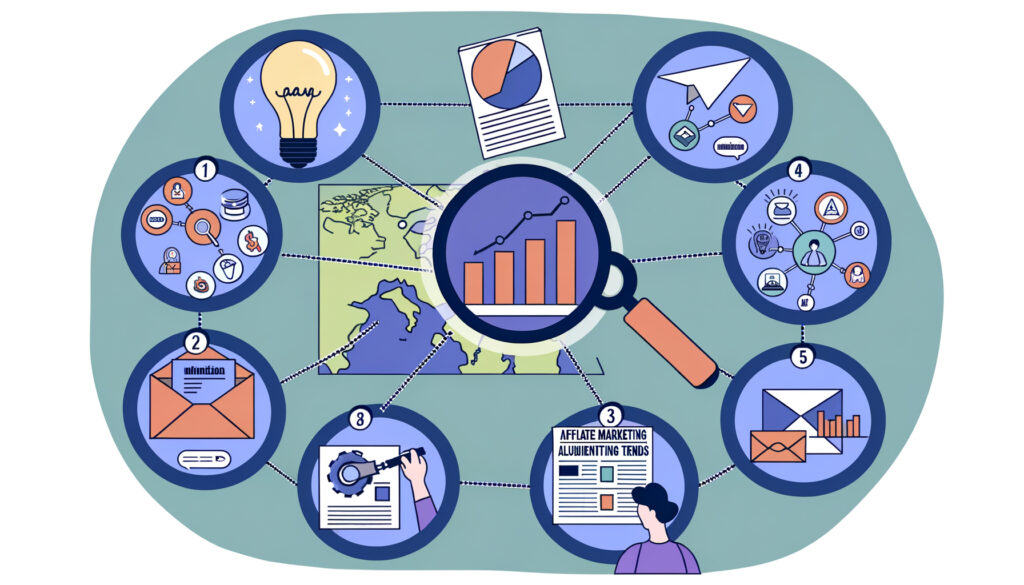
How Affiliate Marketing Works: A Beginner’s Guide to Success so lets Stepping into the world of affiliate marketing can feel overwhelming, but with the right foundation, it becomes an exciting and profitable journey. Think of it as setting up base camp before climbing a mountain: preparation is key to reaching the summit. In this guide, you’ll learn the essential steps to kickstart your affiliate marketing journey and build a sustainable income stream.
1. Choosing Your Niche: The Cornerstone of Affiliate Marketing
Your niche is the foundation of your affiliate marketing business. It’s essential to choose a niche that resonates with your interests and expertise. Why? Because your passion and knowledge will shine through in the content you create, building trust and engagement with your audience.
To find the right niche, ask yourself these questions:
What topics am I genuinely interested in?
What problems can I help others solve?
Is there a market demand for this niche?
- 1. Choosing Your Niche: The Cornerstone of Affiliate Marketing
- Hi, I’m Shawn
- The Anatomy of Affiliate Marketing Success

Affiliate Disclosure
Hi, I’m Shawn
This website contains affiliate links. If you purchase after clicking one of these links, I may earn a small commission at no additional cost to you.
One of these links will take you to Wealthy Affiliate, a platform offering a free one-week trial packed with valuable tools and resources. It’s designed to help you explore whether it aligns with your goals—whether that’s earning income online, starting a blog, or building a thriving website. Wealthy Affiliate provides step-by-step guidance to set you up for success.
Rest assured, clicking these links comes at no cost to you. Instead, they unlock free tools and insights to help kickstart your journey in blogging or online business.
Thank you for visiting! I hope you find this blog helpful and inspiring as you work toward achieving your goals.
Pro Tip: Use tools like Google Trends, and Jaxxy, to research trending niches and validate market demand.
2. Selecting the Right Affiliate Programs
Not all affiliate programs are created equal. Choosing a program that aligns with your niche and values is critical for long-term success. Look for programs with a solid reputation, competitive commission rates, and reliable support for affiliates.
Popular affiliate programs include:
- Wealthy Affiliates; Great for Teaching how to get set up with the online world
- Amazon Associates: Great for a variety of products.
- Jaxxy; Top keyword platform; search Rankings
When evaluating programs, consider:
- Commission structure (e.g., percentage per sale).
- Cookie duration (how long you’ll earn after a customer clicks your link).
- Tools and resources provided for affiliates.
3. Building Your Traffic Source
Traffic is the lifeblood of affiliate marketing. Your choice of platform depends on where your target audience spends their time. Some popular options include:
- Blogs/Websites: Perfect for in-depth content, reviews, and guides.
- YouTube: Great for video tutorials and unboxing reviews.
- Social Media { Facebook, X, Pinterest,): Ideal for quick, engaging promotions.
Pro Tip: Focus on one primary platform when starting, then expand as you grow. For example, if your niche is tech gadgets, you might start with YouTube to showcase product demos.
4. Creating Valuable Content
Content is king in affiliate marketing. Your goal isn’t just to promote products but to provide genuine value that builds trust and credibility. Here’s how:
- Educate: Create tutorials, how-to guides, and explainer videos.
- Review: Share honest reviews about products and services, highlighting their pros and cons.
- Engage: Use personal stories and experiences to connect with your audience.
Pro Tip: Avoid overly sales language. Instead, focus on solving problems and helping your audience make informed decisions.
My recommendation :
Looking to learn about affiliate marketing and see if it’s the right fit for you? Check out my blog, where I share insights on Wealthy Affiliates and how they can help you start building your own online business. I’m here to guide you—not sell to you—so you can make an informed decision that works for your goals. Plus, if Wealthy Affiliates ends up being a good fit for you, they reward me for connecting you to them. It’s a win-win! Check out this Blog
My 2025 Wealthy Affiliates Review! A Journey Breakthrough To Success

5. Engaging with Your Audience
Building a loyal audience is about more than just creating content; it’s about fostering relationships. Respond to comments, ask for feedback, and participate in discussions. The more you engage, the more trust you’ll build.
The Anatomy of Affiliate Marketing Success
Affiliate marketing thrives on a simple yet powerful idea: performance-based rewards. Unlike traditional advertising, where businesses pay for potential exposure (like TV commercials or billboards), affiliate marketing ensures companies only pay when results—like sales or leads—are delivered. Let’s break this down further:
1. Performance-Based Rewards
At its core, affiliate marketing is a results-driven system. Affiliates are only rewarded when they bring measurable value to a business, whether that’s through:
- Conversions: Sales made through the affiliate’s unique link.
- Leads: Potential customers signing up for newsletters, free trials, or other services.
- Clicks: Driving traffic to the company’s website.
This approach creates a win-win scenario: businesses avoid unnecessary ad spend, and affiliates are motivated to optimize their strategies for maximum performance.
2. The Role of Analytics and Tracking
Analytics and tracking tools are the backbone of any successful affiliate campaign. These tools help both businesses and affiliates understand what’s working and what’s not. Here’s how:
- Tracking Affiliate Performance: Platforms like Google Analytics or affiliate dashboards monitor how many clicks, leads, or sales each affiliate generates. This data helps businesses allocate resources effectively and identify top-performing affiliates.
- Conversion Rates: Affiliates can track how many of their clicks lead to actual sales. By analyzing this data, they can tweak their strategies to improve conversions.
- Demographic Insights: Tracking tools often provide information about the audience (age, location, preferences), allowing affiliates to tailor their content to resonate with their specific demographic.
3. Win-Win Partnerships
Affiliate marketing is a symbiotic relationship. Affiliates benefit from earning commissions, while businesses gain increased visibility and sales. To foster strong partnerships:
- Businesses Provide Support: Successful companies invest in their affiliates by offering resources like banners, email templates, or promotional materials. They may also have dedicated affiliate managers to answer questions and share insights.
- Affiliates Drive Value: The most successful affiliates understand their audience and promote products genuinely. This authenticity leads to better results for both parties.
Example: Amazon’s Affiliate Program
Amazon revolutionized affiliate marketing by creating a simple yet effective system where affiliates earn a percentage of sales for driving customers to their platform. Its success stems from its user-friendly tools, robust tracking, and extensive product catalog that appeals to almost any niche.
Best Practices for Long-Term Success
Affiliate marketing is not a “set it and forget it” strategy. To build a thriving business, follow these essential best practices:
1. Diversify Your Efforts
Relying too heavily on one traffic source or affiliate program is risky. For instance:
- A sudden algorithm change on a platform like YouTube or Instagram could reduce your reach overnight.
- A single affiliate program could shut down or lower commission rates.
Solution:
- Use multiple platforms (e.g., blogs, YouTube, social media) to reach a wider audience.
- Partner with various affiliate programs to avoid over-dependence on one income stream.
2. Optimize Your Strategy
Affiliate marketing is a dynamic field, and strategies that worked last year may not work today. Regular optimization involves:
- Testing Content Formats: Experiment with different types of content, such as video reviews, written guides, or email newsletters, to see what resonates most with your audience.
- Adjusting Promotional Strategies: If a specific affiliate product isn’t performing well, consider shifting your focus to products with higher demand or better alignment with your audience’s interests.
- Monitoring Metrics: Key metrics include click-through rates (CTR), conversion rates, and earnings per click (EPC). Use these to refine your campaigns.
3. Build Trust Through Transparency

Trust is the cornerstone of affiliate marketing success. Always disclose your affiliate relationships:
- Add disclaimers such as: “This post contains affiliate links. If you purchase through these links, I may earn a commission at no extra cost to you.”
- Transparency builds credibility and ensures compliance with legal regulations, like the Federal Trade Commission (FTC) guidelines in the U.S. and similar requirements in Canada.
4. Stay Updated on Industry Trends
The digital marketing landscape evolves rapidly. Keep up with trends like:
- AI-Powered Tools: Many affiliates now use AI tools to analyze data, generate content, and optimize campaigns.
- Emerging Platforms: New social media platforms or advertising networks can offer untapped opportunities.
- Niche-Specific Trends: Stay informed about developments in your niche to provide your audience with fresh, relevant content.
Demystifying Affiliate Marketing in Canada
If you’re in Canada, affiliate marketing is not only legal but also thriving. However, it’s essential to operate within the country’s specific legal and ethical framework. Here’s what you need to know:
1. Adherence to Canadian Advertising Standards
Canada has strict regulations to ensure truthful and transparent advertising. Key points include:
- Avoiding Misleading Claims: Do not exaggerate product benefits or make false promises.
- Accurate Disclosures: Clearly state when you’re earning a commission from a product link.
2. Privacy Compliance
Canada’s privacy laws, like the Personal Information Protection and Electronic Documents Act (PIPEDA), regulate how businesses and affiliates handle user data. This includes:
- Cookie Disclosures: If you use cookies to track clicks and conversions, inform your audience about how their data is being used.
- Consent: Ensure that users consent to any data collection practices.
3. Understanding Tax Implications
Affiliate marketing income is subject to taxation in Canada. It is important to maintain thorough records of both your earnings and expenses to facilitate the tax filing process. We recommend seeking guidance from a qualified tax professional who can provide personalized advice based on your circumstances.
Final Thoughts: Unlock Your Affiliate Marketing Potential

Affiliate marketing offers a unique opportunity to turn your passions into profit. It’s a model built on trust, value, and performance. Here’s a quick recap to guide your journey:
- Choose a niche that excites you and aligns with market demand.
- Partner with reputable affiliate programs that offer strong support and fair commissions.
- Create content that educates, entertains, and inspires trust.
- Monitor your performance and adapt your strategies to stay competitive.
By staying authentic and committed, you can build a sustainable affiliate marketing business that grows alongside your expertise. Now is the perfect time to dive in—start small, stay consistent, and watch as your efforts blossom into long-term success.








This guide is a fantastic breakdown of affiliate marketing, making it feel less like an intimidating maze and more like an achievable journey. I really like how it emphasizes trust, transparency, and adaptability three crucial elements often overlooked.
The section on Canadian-specific regulations is a nice touch, as many guides ignore location-based legalities. The balance between strategy and real-world application makes this piece both informative and actionable. One thing I’m curious about is what was the biggest challenge you faced when starting out, and how did you overcome it?
Thank you so much, Kavitha! I really appreciate your kind words and the time you took to share your thoughts. I wanted to make sure this guide felt approachable and practical, so I’m glad that came through!
One of the biggest challenges I faced starting out was information overload—there’s so much advice out there, and it can be overwhelming to know what actually works. I overcame it by focusing on one strategy at a time and testing it out before jumping to the next thing. Once I started seeing what worked (and what didn’t), things became much clearer.
How about you? Have you tried affiliate marketing or considered getting started?
This was such a thorough and motivating guide—thank you for breaking it all down in such a practical and easy-to-follow way!
I especially appreciated the emphasis on building trust through transparency and staying up to date with evolving trends like AI tools.
I’d love to hear your thoughts on a few things:
For someone just starting out, how long does it typically take to see consistent results in affiliate marketing?
What’s your go-to method for driving traffic when launching a brand-new site?
How do you balance promoting affiliate products with creating non-promotional content to keep your audience engaged?
Looking forward to learning more from your experience!
Hey Raymond,
I really appreciate your thoughtful feedback! I’m glad you found the guide practical and easy to follow—making affiliate marketing feel more achievable is exactly what I aim for.
You’ve got some great questions! Here are my thoughts:
1️⃣ How Long to See Consistent Results?
It varies based on effort, niche, and strategy, but most beginners take 6-12 months to see consistent results. The key is consistent content creation, SEO, and audience engagement. If you’re running paid ads or leveraging a strong social media presence, results can come faster.
2️⃣ Go-To Method for Driving Traffic to a New Site?
I start with SEO-driven blog content and pair it with social media engagement. Posting in relevant Facebook groups (without spamming), using Pinterest for evergreen traffic, and repurposing content across platforms (Facebook, X, Instagram) has worked well for me. If you’re interested, Wealthy Affiliate is a great platform that helps with traffic strategies.
3️⃣ Balancing Affiliate Promotions & Non-Promotional Content?
I follow the 80/20 rule—80% valuable, engaging content and 20% promotional. I focus on storytelling, case studies, and how-to guides, which naturally integrate affiliate products without making it feel salesy. The key is to provide value first, so promotions feel like helpful recommendations rather than pitches.
Hope this helps! Thanks again for your support, and I look forward to more great conversations!
Shawn